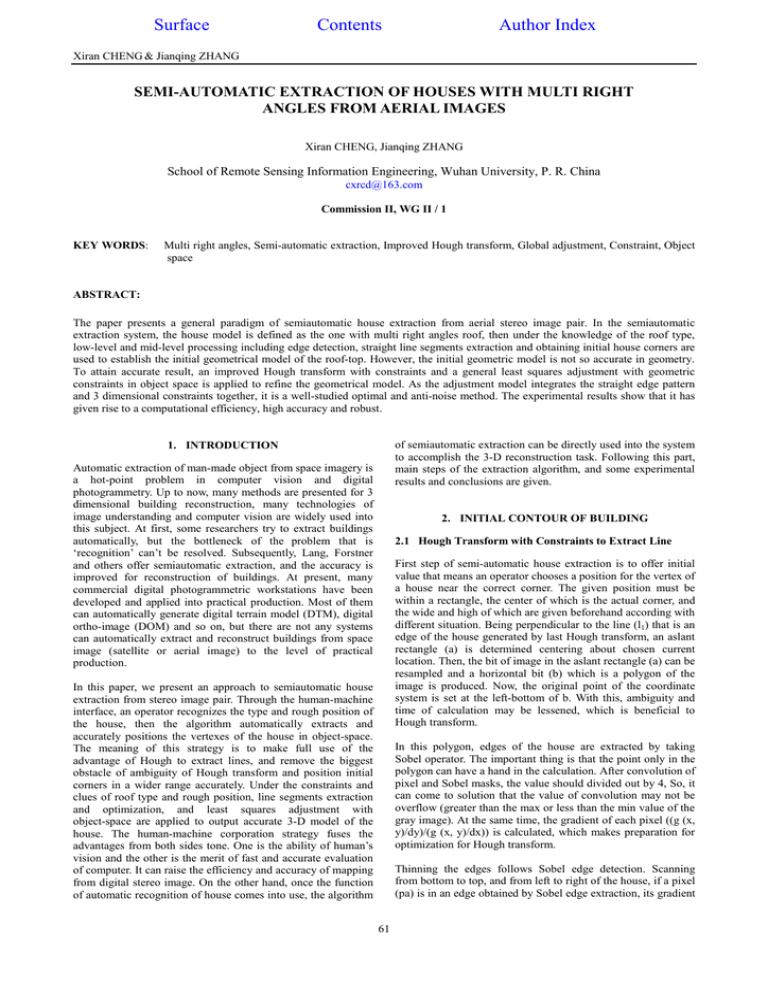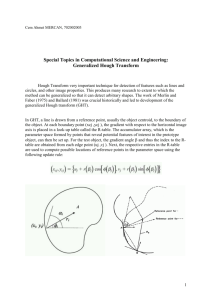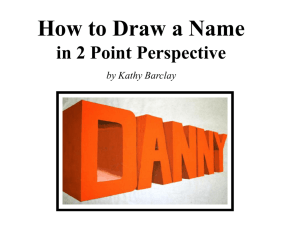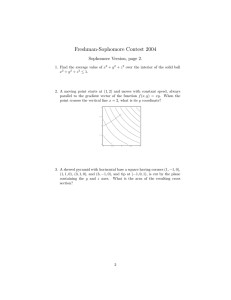SEMI-AUTOMATIC EXTRACTION OF HOUSES WITH MULTI RIGHT ANGLES FROM AERIAL IMAGES
advertisement

Surface
Contents
Author Index
Xiran CHENG & Jianqing ZHANG
SEMI-AUTOMATIC EXTRACTION OF HOUSES WITH MULTI RIGHT
ANGLES FROM AERIAL IMAGES
Xiran CHENG, Jianqing ZHANG
School of Remote Sensing Information Engineering, Wuhan University, P. R. China
cxrcd@163.com
Commission II, WG II / 1
KEY WORDS:
Multi right angles, Semi-automatic extraction, Improved Hough transform, Global adjustment, Constraint, Object
space
ABSTRACT:
The paper presents a general paradigm of semiautomatic house extraction from aerial stereo image pair. In the semiautomatic
extraction system, the house model is defined as the one with multi right angles roof, then under the knowledge of the roof type,
low-level and mid-level processing including edge detection, straight line segments extraction and obtaining initial house corners are
used to establish the initial geometrical model of the roof-top. However, the initial geometric model is not so accurate in geometry.
To attain accurate result, an improved Hough transform with constraints and a general least squares adjustment with geometric
constraints in object space is applied to refine the geometrical model. As the adjustment model integrates the straight edge pattern
and 3 dimensional constraints together, it is a well-studied optimal and anti-noise method. The experimental results show that it has
given rise to a computational efficiency, high accuracy and robust.
of semiautomatic extraction can be directly used into the system
to accomplish the 3-D reconstruction task. Following this part,
main steps of the extraction algorithm, and some experimental
results and conclusions are given.
1. INTRODUCTION
Automatic extraction of man-made object from space imagery is
a hot-point problem in computer vision and digital
photogrammetry. Up to now, many methods are presented for 3
dimensional building reconstruction, many technologies of
image understanding and computer vision are widely used into
this subject. At first, some researchers try to extract buildings
automatically, but the bottleneck of the problem that is
‘recognition’ can’t be resolved. Subsequently, Lang, Forstner
and others offer semiautomatic extraction, and the accuracy is
improved for reconstruction of buildings. At present, many
commercial digital photogrammetric workstations have been
developed and applied into practical production. Most of them
can automatically generate digital terrain model (DTM), digital
ortho-image (DOM) and so on, but there are not any systems
can automatically extract and reconstruct buildings from space
image (satellite or aerial image) to the level of practical
production.
2. INITIAL CONTOUR OF BUILDING
2.1 Hough Transform with Constraints to Extract Line
First step of semi-automatic house extraction is to offer initial
value that means an operator chooses a position for the vertex of
a house near the correct corner. The given position must be
within a rectangle, the center of which is the actual corner, and
the wide and high of which are given beforehand according with
different situation. Being perpendicular to the line (l1) that is an
edge of the house generated by last Hough transform, an aslant
rectangle (a) is determined centering about chosen current
location. Then, the bit of image in the aslant rectangle (a) can be
resampled and a horizontal bit (b) which is a polygon of the
image is produced. Now, the original point of the coordinate
system is set at the left-bottom of b. With this, ambiguity and
time of calculation may be lessened, which is beneficial to
Hough transform.
In this paper, we present an approach to semiautomatic house
extraction from stereo image pair. Through the human-machine
interface, an operator recognizes the type and rough position of
the house, then the algorithm automatically extracts and
accurately positions the vertexes of the house in object-space.
The meaning of this strategy is to make full use of the
advantage of Hough to extract lines, and remove the biggest
obstacle of ambiguity of Hough transform and position initial
corners in a wider range accurately. Under the constraints and
clues of roof type and rough position, line segments extraction
and optimization, and least squares adjustment with
object-space are applied to output accurate 3-D model of the
house. The human-machine corporation strategy fuses the
advantages from both sides tone. One is the ability of human’s
vision and the other is the merit of fast and accurate evaluation
of computer. It can raise the efficiency and accuracy of mapping
from digital stereo image. On the other hand, once the function
of automatic recognition of house comes into use, the algorithm
In this polygon, edges of the house are extracted by taking
Sobel operator. The important thing is that the point only in the
polygon can have a hand in the calculation. After convolution of
pixel and Sobel masks, the value should divided out by 4, So, it
can come to solution that the value of convolution may not be
overflow (greater than the max or less than the min value of the
gray image). At the same time, the gradient of each pixel ((g (x,
y)/dy)/(g (x, y)/dx)) is calculated, which makes preparation for
optimization for Hough transform.
Thinning the edges follows Sobel edge detection. Scanning
from bottom to top, and from left to right of the house, if a pixel
(pa) is in an edge obtained by Sobel edge extraction, its gradient
61
IAPRS, VOLUME XXXIV, PART 2, COMMISION II, Xi’an, Aug.20-23, 2002
is compared to the gradient of its adjacent two pixels in the
direction of the gradient of pa, the pixel with maximum gradient
value is edge pixel and reserved, accordingly, the other two
pixels are not on the edge and deleted. This method is simple
and efficient, because it makes full use of the value of gradient
of each pixel. Then, after thinning, isolating point that
contributes little to Hough transform must be deleted according
with calculation the number of its connection, because many
isolating points are noise or belong to another objects and their
wrong gradients may lead to wrong Hough transform
∆α = ∆r / t
(1)
∆r = ρ1 − ρ 2
ρ1 = x cosθ1 + y sin θ1
ρ 2 = x cosθ 2 + y sin θ 2
where
Line positioning comes after points in the edges having been
determined. In this scheme, the two parameters in the polar
coordinate system are ρand θ, ρ is the geometric distance,
θ can not locate in the third quadrant as a consequent of the
transform of coordinate systems and the position of the bit of
this image. When Hough transform is done, an accumulator is
constructed. At the same time, the slope of this line is put down.
The direction of the line that is perpendicular to an edge of a
house is the gradient(θ)of the pixel in the edge theoretically,
but the calculated gradient of a point is inaccurate. According as
polygon approximation, the calculation of accumulator is done
not only to the parameter unit of θ,but also to the parameter
units of θ±Δθ.Here, Δθis limited.
∆α=decalage of l1 and l2
∆r=distance of PP’
θ1=angle component of l1 in polar coordinate system
θ2=angle component of l2 in polar coordinate system
t= length of a valid segment
The second one is the length constrain. In the Figure 2.1-2, l2’ is
the parallel line of l2 , and segment BE is one part of line l1 (r1,
θ1) . P is the intersection of BE and l2. EE’, BB’ and PP’ are
perpendicular to l2’ , and B’, P’, E’ are in l2’.
min {| θ − θ g |, | θ − θ g + π |} < 3σ θ
∆ θ = min {| θ − θ g |, | θ − θ g + π |}
Figure 2.1-2
where
θ =angle component in the polar coordinate system
θ g =gradient of a pixel
min{rb , re } ≤ r ≤ max{rb , re }
σ θ =contrast
where
After each point finishes accumulation, repeat segments must be
deleted to obtain the accurate edge. Because part of pixels in
one edge may be in another one by being calculated. First, local
maximum value should be obtained. So, approximate thresholds
of dρand dθ (where: dρ denotes the span of ρ,and dθis
the span of θfor two iterate segments of two lines) are given
by experiment. Second, repeat segments are deleted
preliminarily. Line l1 intersects line l2 in a local region, and their
decalage is less than Δ θ (generally, it is less than 10
degree),and at the same time, the diversity of polar length of the
two lines are less than ∆ρ, then, the shorter line is deleted. To
obtain as good result of Hough transform as possible, more
work must be done. If some points in Line l1 are in Line l2 at the
same time, two constraints have to be considered. The first is
their decalage ∆α. In the Figure 2.1-1, P is a point in l1, PP’ is
orthogonal of l2, and point P’ is in l2.
(2)
rb =the distance of BB’
re =the distance of EE’.
r=the distance of PP’
The constraint (1) (2) must be valid when the segment BE is a
repeat part of l2. If all points in one line (l1) are all in line(l2),
line l1 is deleted, and if part of l1 is in l2 and the contrast radio of
l1 and l2 is larger than a value that is predestined, and l2 is longer
than l1, l1 should be deleted.
2.2 Initial Value of Corners
Initial position of a corner is the intersection of two
perpendicular edges. When edge information of one corner of a
house are too ambiguity to extract good lines, the extracted lines
of its two neighbour corners can determine that corner. If this is
failed, it must determine artificially. After candidate corners are
extracted, candidate intersections of each corner are put down
for further procession in turn according to the area of a polygon
that consists of candidate corners. The same work must done in
the other epipolar image to obtain the candidate corners of the
same house. So far, the initial contour of a house is extracted.
3. GENERAL ADJUSTMENT WITH GEOMETRIC
CONSTRAINTS IN OBJECT SPACE
Figure 2.1-1
3.1 Error Equation
With the help of full digital photogrammetry system Virtuozo,
62
Xiran CHENG & Jianqing ZHANG
dy ri − dy li − ( y ri − y li ) = 0
two epipolar images and their positions in object space can be
gotten. In the Figure 3-1, two epipolar images are given at the
top. Four corners of the roof of this house are represented by a,
b, c, d distinguishingly. In object space, corners are A, B, C, D
accordingly. According with forward intersection, the
coordinates of corners are calculated ( Xˆ , Yˆ , Zˆ ) in object
space. As the observation values, these candidate corners (x, y)
in images are inaccurate, and shift along x and y is dx and dy
distinguishingly, which causes inaccurate coordinates of object
in object space, and it is same on the contrary. The shift of a
point in object space is signified with dX, dY, dZ. Then, having
the coordinates of object in object space as the parameters, the
error equations of indirect adjustment can be listed based on
resection.
dy ri = f lyi ( dX i , dY i , dZ i )
dy li = f ryi ( dX i , dY i , dZ i )
3.2.2
Straight Angle Constraint
In an image, two line consisting of a straight angle may be not
vertical for geometric distortion because of projection. So, the
constraint must be given based on object space.
( X a − X C )dX b + ( X c + X b − 2 X a )dX a
+ ( X a − X b )dX c + (Ya − YC )dYb
(5)
+ (Yb + Yc − Ya )dYa + (Ya − Yb )dYc − L = 0
dx lxi = f lxi ( dX i , dY i , dZ i )
dy lyi = f lyi ( dX i , dY i , dZ i )
(4)
(3)
dx rxi = f rxi ( dX i , dY i , dZ i )
where Xi=coordinate of corner I in object space along X axle
Yi=coordinate of corner I in object space along Y axle
Zi=coordinate of corner I in object space along Z axle
i= sequence number of a, b, c
I= sequence number of A,B,C
dy ryi = f ryi ( dX i , dY i , dZ i )
3.2.3
Equal Altitude
For a house with multi straight angles, altitudes of its corners
are equal.
∆Z i − ∆Z i −1 + Z i − Z i −1 = 0
where
(6)
∆Zi=altitude of corner i
i-1,i,i+1=three serial corners in object space
Together with the error equations (3) and Constraints (4) (5) (6),
the function model of indirect adjustment with constraints can
be created, and the corners of the house can be positioned
accurately by calculation of least square adjustment.
4. EXPERIMENT AND CONCLUSION
4.1 Experiments
4.1.1
No.1
A aerial gray image and the extraction results appear in Figure
4.1.1-1, 4.1.1-2. In the Figure 4.1.1-1, there is a house with
multi straight angles. It can be seen that the contour of house is
extracted correctly. In the Fig 4.1.1-2, it displays a corner that is
sextuple than that of 4.1.1-1. The initial position of the corner is
given artificially that is represented by a red cross, and a green
cross represents the extracted corner. From the figure, it is clear
that the corner is extracted accurately even if the diversity of the
initial point and the genuine one is close to 10 pixels. As a result,
when an operator mapping, he can fell much more relaxed and
easy for decreasing work., at the same time, it is more
accurately than man does so.
Figure 3-1
3.2 Constraint Equations
3.2.1
Experiment
Zero Parallax of Vertical Orientation
In epipolar image pair, homonymous points are in the same
horizontal line. As a result, there is not parallax in vertical
orientation for the two homonymous points in an epipolar image
pair, and the parallax in horizontal orientation decides the
altitude of the homologous point in object space. Then, the
constraint equation is produced.
4.1.2
Experiment
No.2
In the Figure 4.1.2-1, it is an original aerial gray image. After
edge extraction, points in edges are extracted and displayed as
pixels with 256 gray in the Figure 4.1.2-2. The edge information
is not bountiful, and there are so much noise. The Figure 4.1.2-3
63
IAPRS, VOLUME XXXIV, PART 2, COMMISION II, Xi’an, Aug.20-23, 2002
is an original image. It is clear that edge with a little fringe
points and much noise is extracted correctly, and the contour of
this house that is drawn with red lines is peripheral. In Figure
4.1.2-4, the image is sextuple than original image. The green
cross is initial inputting position of a corner, and the red cross
means the extracted corner.
extracting multi straight angles house, the advantage of Hough
transform enables it to prevent the noise, and the geometrical
conditions decide the alone and superior initial position of a
corner. The least square adjustment with constraints of object
space positions the house accurately last.
However, this approach is appropriate for a house with multi
straight angles only. There is a great potential for generating an
efficient scheme to extract other kind of complicated houses.
For complicated house, different method may be applied for
corner and edge with different character.
4.2 Conclusion
The application indicates that the algorithm is one algorithm
with good interactivity, a measure of interference immunity,
good accuracy, high speed and more efficiency. Aiming at
Figure 4.1.1-1
Figure 4.1.1-2
A little good edge
information
Figure 4.1.2-1
Figure 4.1.2-2
This edge can extracted
accurately
A corner
amibiguity
Figure 4.1.2-3
Figure 4.1.2-4
64
without
Xiran CHENG & Jianqing ZHANG
REFERENCES
Heipke, C., 1992. A Global Approach for least-squares image
matching and surface reconstruction in object space,
Photogrammetric Engineering & Remote Sensing Vol.58, No 3,
pp. 317-323.
Leng C., 1996. Improved Hough transform and it’s parallel
computing, Acta Electronica Sinica, Vol.24, pp. 110-114.
Shih-Hong, C., 2000. Interactive roof patch reconstruction
based on 3-D liner segments. International Archives of
Photogrammetry and Remote Sensing. Vol.XXXIII, Part B3,
pp.183-190.
Xiangyun, H., 2001. Automatic Extraction of Linear Objects
and Houses from Aerial and Remote Sensing Imagery, Doctor
Dissertation. pp.59-83. Wuhan.
Zuxun Z., Jianqing Z., 2000.Semiautomatic Building Extraction
Based on Least Squares Matching with Geometrical Constraints
in Object Space, International Archives of Photogrammetry and
Remote Sensing. Vol XXXIII, Part B3. Amersterdam.
65
IAPRS, VOLUME XXXIV, PART 2, COMMISION II, Xi’an, Aug.20-23, 2002
66






